What is Lawn Aeration?
Definition
Aeration is the process of creating holes down into the soil to alleviate compaction so air, water, and nutrients can reach grass roots. Think of it as giving your lawn room to breathe properly.
The technique involves perforating the soil with small holes to allow air, water and nutrients to penetrate the grass roots. Your lawn gets what it needs to thrive and grow thick.
Basically you are perforating your lawn with many holes to break up the soil and let it breathe, allowing water, air and nutrients to seep in. It is like opening windows in a stuffy room.
How the Process Works
The magic happens when you start removing plugs of soil in order to break up soil compaction, allowing oxygen and water to reach the root zone. Those small openings make a huge difference in grass health.
You are piercing through the top layer of soil or removing plugs of turf to expose roots and soil to the elements. Fresh air reaches buried roots that have been struggling for years.
The goal is puncturing small openings in your lawn to relieve soil compaction and enhance the delivery of vital elements. Water flows deeper instead of running off the surface during heavy rains.
The Science Behind Aeration
Here is something most homeowners don’t know. Soils are generally 50% pore space and 50% solid. The pore space is needed to conduct water and oxygen to your turf. When that space gets compressed, grass suffers.
Even worse, a layer of compacted soil just 1/4 to 1/2 inches thick can make a significant difference in the health and beauty of your lawn. That’s thinner than your smartphone but creates massive problems below ground.
Why Lawn Aeration Matters
The Root Growth Benefits
This helps the roots grow deeply and produce a stronger, more vigorous lawn. Deep roots mean better drought tolerance and overall plant health.
A lawn receiving aeration at the right time allows much-needed water and oxygen into the root zone. Your grass finally gets the resources it is been craving all along.
The process allows oxygen, nutrients and water to penetrate deep into the root zone. Strong roots create thick grass that crowds out weeds naturally.
Solving Soil Compaction Problems
Deprived of their basic needs by compacted soil, grass cannot thrive. It is like trying to grow plants in concrete nearly impossible without intervention.
Compacted soil prevents proper water infiltration and air circulation. Rain sits on top instead of soaking down to thirsty roots below.
Compaction is the reduction of soil pore space which limits essential resources. Your expensive fertilizer and water can not reach the places where they are needed most.
Improving Water and Nutrient Access
Aeration breaks through barriers that prevent water absorption. Suddenly your irrigation system becomes way more effective at keeping grass green.
The process enhances fertilizer effectiveness by creating pathways to root zones. You will get better results from the same amount of lawn products.
It also reduces water runoff and improves drought resistance. Your grass survives dry spells better because roots can access moisture stored deeper underground.
Signs Your Lawn Needs Aeration
Physical Signs of Soil Compaction
If your grass often looks stressed and your soil is hard to the touch or rainwater puddles up where it used to be absorbed, you may have compaction problems. These are clear warning signals that should not be ignored.
A classic sign of soil compaction is when a lawn feels bone dry and dense to the touch and rock hard underfoot. Walking across your yard feels like stepping on concrete.
If you have a hard time digging into soil with a shovel, then the soil probably is compacted. Simple tools struggle to penetrate the surface layer.
Visual Grass Health Indicators
If you see patches of bare soil in your yard or areas where plants or grass grow poorly, then the soil may be compacted. Healthy soil supports consistent growth across the entire lawn.
If your grass is discolored and is filled with brown and yellow patches it is a sign that it’s struggling and lacks nutrients. Even with regular feeding, the grass stays weak and pale.
If you notice your grass has stopped growing or growing at a very slow pace, it may be time to aerate. Growth should be steady throughout the growing season.
Simple Tests to Confirm Need
Confirm your suspicions with a simple “screwdriver test.” Take a regular screwdriver and stick it into your lawn’s soil by hand. Difficulty pushing it down means compaction problems.
Using a screwdriver or even a pencil, you can test to see if the soil is compacted. Stick the object into the ground and see if you have difficulty. Healthy soil allows easy penetration.
You may also have difficulty inserting trowels or shovels into the soil. Gardening tools should slide into good soil without much force.
Water-Related Warning Signs
Signs include compacted soil, water pooling, sparse grass growth and thinning patches. Multiple symptoms often appear together in problem areas.
Water running off instead of soaking in creates obvious problems. You will see streams flowing across your lawn during moderate rainfall.
Lawn drying out quickly after watering indicates poor water retention. The soil can not hold moisture because there is nowhere for it to go.
Thatch-Related Issues
When thatch (bits of grass that have died and gathered just above the soil line) is too thick, your lawn will feel spongy. A little thatch is normal, but too much blocks essential resources.
Apart from a hard lawn surface your grass may have thatch, dry quickly, grow unevenly or in patches. Multiple problems often occur simultaneously in neglected lawns.
Types of Lawn Aeration
Core Aeration (Plug Aeration)
Core aeration stands as the most effective method for breaking up compacted soil. This technique actually removes soil plugs rather than just poking holes.
The process removes actual plugs of soil, creating permanent holes that stay open longer. Grass roots can expand into these spaces immediately.
Professional landscapers recommend this approach for severely compacted lawns. It provides the most dramatic and long-lasting results for struggling grass.
Core aeration works best for severely compacted lawns where other methods have failed. The investment pays off in dramatically improved grass health.
Spike Aeration
Spike aeration uses solid spikes to create holes without removing soil. It’s quicker and cheaper than core aeration but offers limited benefits.
This method can be less effective than core aeration for serious compaction issues. The holes often close up quickly, especially in clay-heavy soils.
Spike aeration can potentially worsen compaction in clay soils by pushing dirt sideways rather than removing it. Choose this method carefully based on your soil type.
The technique is suitable only for lightly compacted lawns that need minor improvement. Don’t expect dramatic results from spike aeration alone.
Liquid Aeration
Chemical treatment breaks down soil particles rather than creating physical holes. It is easier to apply but effectiveness varies widely between products.
Liquid aeration works well for maintenance between mechanical aerations. Think of it as a supplement rather than a replacement for core aeration.
Most experts don’t recommend liquid aeration as the sole solution for severe compaction. Physical methods work better for seriously damaged lawns.
When and How Often to Aerate
Optimal Timing for Aeration
Best timing varies by grass type and climate conditions in your area. Cool-season and warm-season grasses have different optimal windows.
Aeration is generally recommended during active growing seasons when grass can recover quickly. Avoid treating dormant lawns that can’t heal properly.
Fall timing often works best for cool-season grasses like fescue and bluegrass. Spring timing suits warm-season varieties including Bermuda and Zoysia better.
Frequency Recommendations
Most lawns benefit from annual aeration to maintain optimal soil conditions. Consistency matters more than perfect timing in most situations.
High-traffic areas or lawns with heavy clay soil may need aeration twice a year. These challenging conditions require more aggressive treatment schedules.
New lawns may need more frequent aeration initially while establishing root systems. Well-established, healthy lawns may need less frequent treatment over time.
Expected Results and Timeline
Immediate Effects
You will see visible holes throughout your lawn surface right after treatment. The appearance looks temporarily disturbed but this is completely normal.
Core aeration leaves soil plugs scattered on grass that break down naturally over several weeks. Don’t rake them up – they add valuable organic matter back to your lawn.
Initial appearance may look messy but resist the urge to clean up immediately. Those soil plugs contain beneficial microorganisms and nutrients.
Short-term Improvements (2-4 weeks)
Better water infiltration shows up within just a few days after treatment. You will notice less surface runoff during the next rainfall.
Reduced water pooling becomes obvious during the first heavy rain following aeration. Water soaks in rather than sitting on top.
Improved air circulation in soil happens immediately but grass response takes slightly longer. Roots need time to grow into newly available spaces.
Long-term Benefits (Growing season)
Aeration increases soil moisture and softness by providing grass better access to water stored deeper underground. Drought tolerance improves significantly over time.
Deeper, healthier root systems develop throughout the following growing season. Strong roots mean more resilient grass that bounces back from stress.
Thicker, more resilient grass growth becomes obvious by the next spring. Your lawn crowds out weeds naturally when it’s healthy and vigorous.
Better drought tolerance and overall lawn health develop gradually but last for years. Properly aerated lawns require less water and survive stress better than untreated areas.






